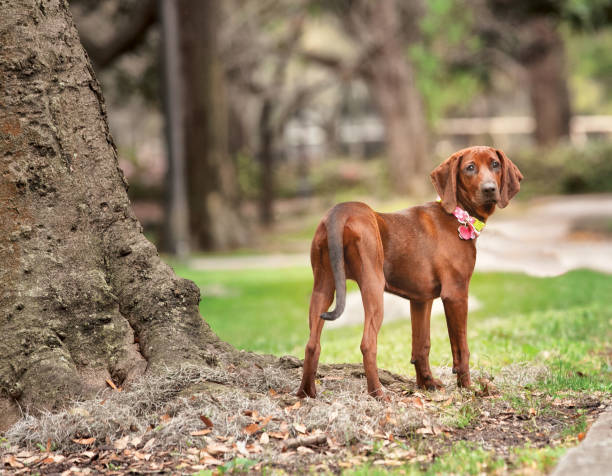Redbone Coonhound

Breed History:
The Redbone Coonhound is an American scent hound developed in the Southern United States in the late 18th and early 19th centuries. It was bred specifically for tracking and treeing raccoons, but also capable of hunting larger game like bear, deer, and cougar.
Early settlers crossed Foxhounds from Europe with Bloodhounds and other hounds, selecting for a solid red coat, strong scenting ability, and a bold, determined nature. Over time, the breed evolved into a versatile hunting dog that excelled on rough terrain and could work day or night.
Recognised by the United Kennel Club (UKC) in 1902 and later by the AKC in 2009, the Redbone Coonhound remains a favourite among hunters and outdoor enthusiasts.
|
Gender |
Height |
Weight |
|
Male |
56-68 cm |
25-32 kg |
|
Female |
53-66 cm |
20-30 kg |
Size: Medium to Large
Life Expectancy: 12–14 years

Breed Appearance:
The Redbone Coonhound is a well-muscled, balanced dog with a lean, athletic build. It has a broad head, long, drooping ears, and expressive, dark brown eyes.
The coat is short, smooth, and glossy, always in a rich, solid red colour—a defining trait of the breed. The tail is long and tapers slightly, carried high when the dog is active.
Breed Type – Scent Hound / Coonhound:
This is a versatile scent hound, bred to track and tree game animals using its excellent nose and vocal "baying" to alert hunters. It’s determined and fearless on the trail, but easygoing and affectionate at home.
Redbones are known for their loyalty and companionship, especially with families that can match their energy and intelligence.

Training:
Redbones are intelligent but independent, with a strong prey drive and a deep desire to follow scents. Training requires:
-
Consistency and patience
-
Early socialisation and recall training
-
Positive reinforcement over harsh discipline
They can be stubborn when a scent catches their interest, so reliable leash training is essential.
Health & Care:
Generally a healthy breed, but can be prone to:
-
Hip dysplasia
-
Ear infections (due to long ears)
-
Eye conditions (entropion, cataracts)
-
Bloat (gastric torsion)
Regular ear cleaning, joint care, and a high-quality diet support their long-term health. Regular vet checkups are recommended, especially in active hunting dogs.

Living Conditions:
The Redbone Coonhound thrives in rural or suburban homes with plenty of space. It is not ideal for apartments due to its energy level and vocal nature.
While affectionate and gentle indoors, this breed requires frequent exercise and outdoor time. It’s best suited for active households that enjoy hiking, running, or hunting.
Exercise:
High exercise needs:
-
Daily long walks or runs
-
Off-leash play in secure areas
-
Scent work or tracking games
-
Hiking, hunting, or exploring nature
Without enough activity, Redbones can become bored, vocal, or destructive.
Grooming:
Low grooming needs:
-
Weekly brushing to remove loose hair
-
Regular ear cleaning to prevent infections
-
Nail trimming and dental care as needed
-
Bathing only occasionally
The coat is low-maintenance and weather-resistant, but moderate seasonal shedding may occur.

Advantages:
-
Excellent scent-tracking and hunting skills
-
Friendly, loyal, and affectionate with family
-
Low grooming
-
Athletic and agile—great for active owners
-
Adaptable as both a working dog and a companion
-
Distinctive and beautiful red coat
Disadvantages:
-
High energy and exercise needs
-
Prone to chasing scents—must be leashed or fenced
-
Not suited for apartment living or sedentary homes
-
Can be vocal and bay loudly
-
Independent—may be stubborn in training
-
Needs early socialisation to avoid aloofness with strangers

